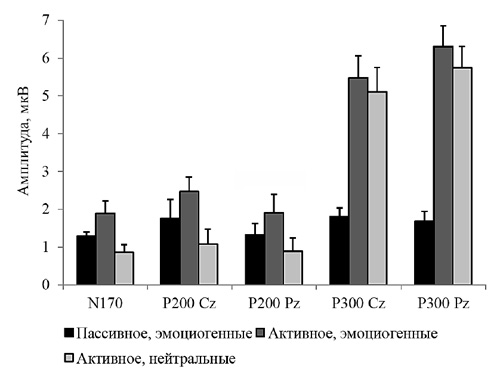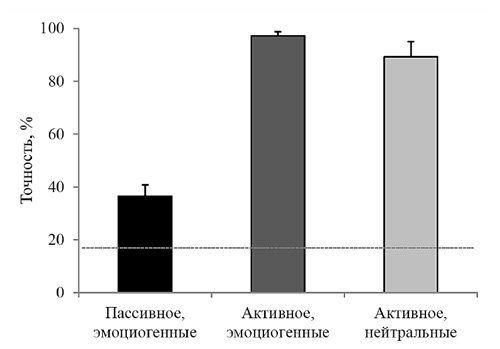Article
Ganin I.P., Kosichenko E.A., Kaplan A.Ya. (2018). Detecting of subjective focus of interest to emotionally significant stimuli in P300-based brain-computer interface. Moscow University Psychology Bulletin, 1, 3-20
Abstract
Relevance. P300-based brain-computer interface (P300 BCI) enables a user to choose commands by consciously attending to certain visual stimulus. However, P300 BCI-based systems for detection of covert focuses of human interest, including emotional stimuli, can be built and applied in systems for monitoring human’s normal and pathological state.
Objective. The objective was to investigate the properties of perception of stimuli with different subjective emotional significance for the person and to evaluate the possibility of P300 BCI-based detection of covert emotional focuses of attention.
Methods. 14 healthy subjects participated in the EEG-study with consequent presenting of visual stimuli with emotional or neutral human faces photos. In the first block the participants’ task was just to look at the screen with appearing stimuli (passive attention) while one of six stimuli in each trial was emotional. In the other two blocks the task was to silently count the number of the target stimulus presentations among non-target stimuli (active attention) with emotional or neutral target stimulus depending on the block. We analyzed the event-related potentials (ERP) for stimuli of different classes and the classifica-tion accuracy for target (or emotional) stimulus in P300 BCI-similar fashion.
Results. In this study we showed that the accuracy of presented in passive viewing paradigm emotional stimuli recognition exceeded the random level more than twice. Also we found characteristic features of the potentials in response to stimuli with various significance.
Conclusions. The obtained results create opportunities for developing the clinically applicable P300 BCI-based systems for detection of covert attentional focuses.
Sections: Empirical studies;
Received: 02/13/2018Accepted: 02/20/2018
Pages: 3-20
DOI: 10.11621/vsp.2018.01.03
Keywords: brain-computer interface (BCI); event-related potentials (ERP); potential; P300 wave; emotional stimulus; active attention; passive attention;
Available Online 30.03.2018

Pic. 1.

Pic. 2.
References:
Asmaro, D., Carolan, P.L., Liotti, M. (2014). Electrophysiological evidence of early attentional bias to drug-related pictures in chronic cannabis users. Addictive Behaviors, 39, 1, 114—121. doi.org/10.1016/j.addbeh.2013.09.012
Carretie, L., Hinojosa, J.A., Martin-Loeches, M. et al. (2004). Automatic attention to emotional stimuli: Neural correlates. Human Brain Mapping, 22, 4, 290—299. doi.org/10.1002/hbm.20037
Cauquil, A.S., Edmonds, G.E., Taylor, M.J. (2000). Is the face-sensitive N170 the only ERP not affected by selective attention? NeuroReport, 11, 2167—2171. doi.org/10.1097/00001756-200007140-00021
Delplanque, S., Silvert, L., Hot, P., Sequeira, H. (2005). Event-related P3a and P3b in response to unpredictable emotional stimuli. Biological Psychology, 68, 107—120. doi.org/10.1016/j.biopsycho.2004.04.006
Farwell, L.A., Donchin, E. (1988). Talking off the top of your head: toward a mental prosthesis utilizing event-related brain potentials. Electroencephalography and Clinical Neurophysiology, 70, 510—523. doi.org/10.1016/0013-4694(88)90149-6
Ganin, I.P., Kosichenko, E.A., Kaplan, A.Ya. (2017). Osobennosti elektroentsefalograficheskikh reaktsiy na emotsional‘no znachimye stimuly v tekhnologii interfeysa mozg-komp‘yuter na volne P300. Zhurnal vysshey nervnoy deyatel‘nosti [Journal of Higher Nervous Activity], 67, 4, 453—463.
Genetti, M., Khateb, A., Heinzer, S. et al. (2009). Temporal dynamics of awareness for facial identity revealed with ERP. Brain and Cognition, 69, 2, 296—305. doi.org/10.1016/j.bandc.2008.08.008
Hobson, R.P., Ouston, J., Lee, A. (1988). Emotion recognition in autism: Coordinating faces and voices. Psychological Medicine, 18, 4, 911—923. doi.org/10.1017/S0033291700009843
Jin, J., Allison, B.Z., Kaufmann, T. et al. (2012). The changing face of P300 BCIs: a comparison of stimulus changes in a P300 BCI involving faces, emotion, and movement. PLoS One, 7, 11, e49688. doi.org/10.1371/journal.pone.0049688
Kaplan, A.Ya. (2016). Neyrofiziologicheskie osnovaniya i prakticheskie realizatsii tekhnologii mozg-mashinnykh interfeysov v nevrologicheskoy reabilitatsii. Fiziologiya cheloveka [Human Physiology], 42, 1, 118—127.
Kaplan, A.Y., Shishkin, S.L., Ganin, I.P. et al. (2013). Adapting the P300-based brain-computer interface for gaming: a review. IEEE transactions on computational intelligence and AI in games (Special Issue on Brain/Neuronal-Computer Games Interfaces and Interaction), 5, 2, 141—149. doi.org/10.1109/TCIAIG.2012.2237517
Kaufmann, T., Schulz, S.M., Köblitz, A. et al. (2013). Face stimuli effectively prevent brain-computer interface inefficiency in patients with neurodegenerative disease. Clinical Neurophysiology, 124, 893—900. doi.org/10.1016/j.clinph.2012.11.006
Keil, A., Bradley, M.M., Hauk, O. et al. (2002). Large-scale neural correlates of affective picture processing. Psychophysiology, 39, 641—649. doi.org/10.1111/1469-8986.3950641
Kubo, K., Nittono, H. (2009). The role of intention to conceal in the P300-based concealed information test. Applied Psychophysiology and Biofeedback, 34, 3, 227—235. doi.org/10.1007/s10484-009-9089-y
Luck, S.J. (2005). An Introduction to the Event-Related Potential Technique. Cambridge, MA: The MIT Press.
Minear, M., Park, D.C. (2000). A lifespan database of adult facial stimuli. Behavior Research Methods, Instruments, & Computers, 36, 4, 630—633. doi.org/10.3758/BF03206543
Mitsudo, T., Kamio, Y., Goto, Y. et al. (2011). Neural responses in the occipital cortex to unrecognizable faces. Clinical Neurophysiology, 122, 4, 708—718. doi.org/10.1016/j.clinph.2010.10.004
Ohman, A., Flykt, A., Esteves, F. (2001). Emotion drives attention: detecting the snake in the grass. Journal of Experimental Psychology: General, 130, 3, 466—478. doi.org/10.1037/0096-3445.130.3.466
Picton, T.W. (1992). The P300 wave of the human event-related potential. Journal of Clinical Neurophysiology, 9, 456—479. doi.org/10.1097/00004691-199210000-00002
Polich, J. (1989). P300 from a passive auditory paradigm // Electroencephalography and Clinical Neurophysiology, 74, 312—320. doi.org/10.1016/0168-5597(89)90061-0
Sabatinelli, D., Lang, P.J., Keil, A., Bradley, M.M. (2007). Emotional perception: Correlation of functional MRI and event-related potentials. Cerebral Cortex, 17, 1085—1091. doi.org/10.1093/cercor/bhl017
Schupp, H.T., Junghöfer, M., Weike, A.I., Hamm, A.O. (2003). Attention and emotion: an ERP analysis of facilitated emotional stimulus processing. NeuroReport, 14, 8, 1107—1110. doi.org/10.1097/00001756-200306110-00002
Singh, M., Singh, M., Goyal, M. (2015). Selection of attribute combinations of ERP’s for classification of emotions along arousal axis. International Journal of Information Technology & Knowledge Management, 8, 2, 142—149.
Sprengelmeyer, R., Jentzsch, I. (2006). Event related potentials and the perception of intensity in facial expressions. Neuropsychologia, 44, 2899—2906. doi.org/10.1016/j.neuropsychologia.2006.06.020
Wolpaw, J.R. (2007). Brain-computer interfaces as new brain output pathways. The Journal of Physiology, 579, 3, 613—619. doi.org/10.1113/jphysiol.2006.125948
For citing this article:
Ganin I.P., Kosichenko E.A., Kaplan A.Ya. (2018). Detecting of subjective focus of interest to emotionally significant stimuli in P300-based brain-computer interface. Moscow University Psychology Bulletin, 1, 3-20








